Key takeaways:
- Activism against the death penalty is driven by the belief in human rights and the emotional toll on families impacted by wrongful executions.
- Historical perspectives on capital punishment highlight society’s evolving views on justice, transitioning from acceptance to questioning its morality.
- Effective advocacy includes storytelling, grassroots organizing, and leveraging social media to broaden engagement and foster community discussions.
- Key lessons from activism stress the importance of listening, persistence in efforts, and prioritizing self-care for sustainable involvement in social justice movements.
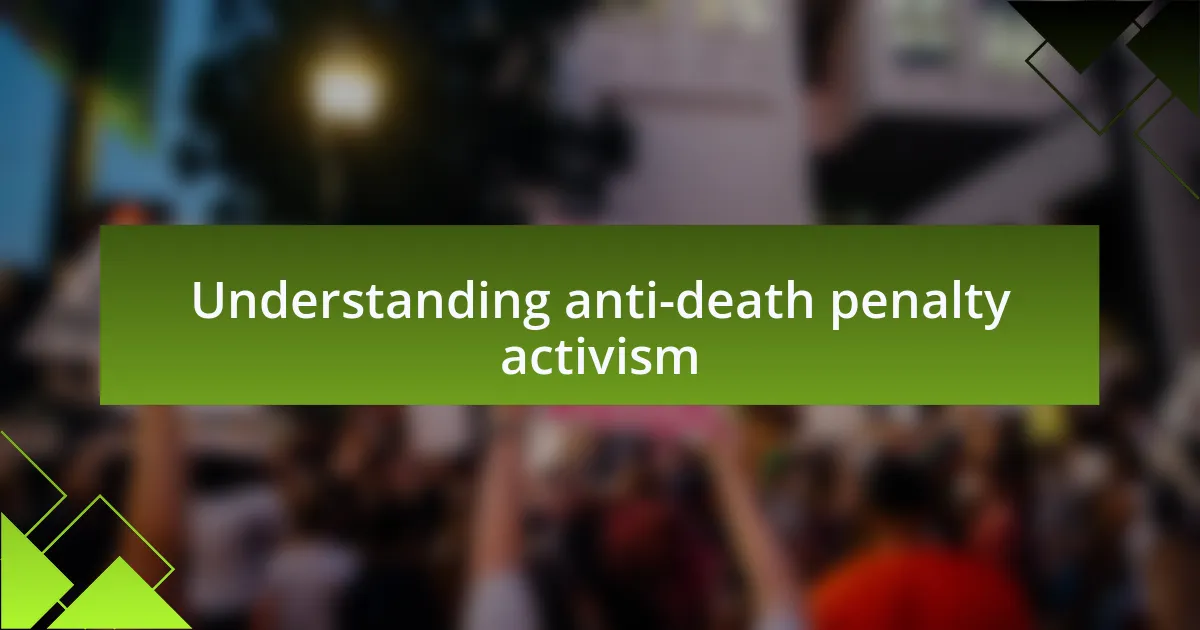
Understanding anti-death penalty activism
Activism against the death penalty is rooted in deeply held beliefs about human rights and justice. For me, understanding the stories behind those who have faced capital punishment—often wrongfully—fuels my passion for this cause. How can we justify a system that can take a life, knowing it may be based on flawed evidence or bias?
Engaging with survivors and families of victims has given me a profound insight into the emotional toll of the death penalty. Their narratives reveal a complex blend of grief and anger, which often leads to a desire for true justice rather than retribution. Isn’t it crucial to listen to these voices and consider what they truly seek: closure or a chance for redemption?
Throughout my journey in anti-death penalty activism, I’ve learned that change often comes from consistent education and dialogue. I remember participating in a community event where, through shared experiences and discussions, we began to dismantle misconceptions about the death penalty’s effectiveness. This moment made me realize that fostering understanding is just as vital as advocating for policy changes—don’t we owe it to ourselves to engage deeply and compassionately with this pressing issue?
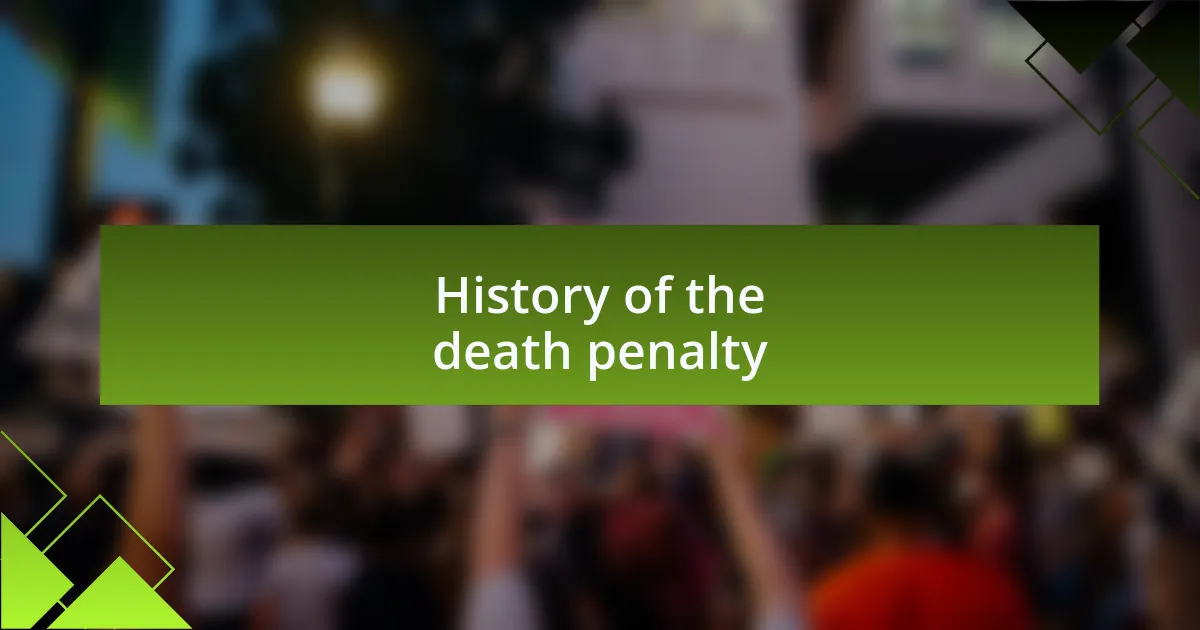
History of the death penalty
The history of the death penalty stretches back thousands of years, with records showing its use in ancient civilizations like Babylon and Greece. I often find myself reflecting on how society once accepted this ultimate form of punishment as a primary means of justice, sparking a deep internal conflict for me: How did we move from viewing execution as a necessary tool to questioning its morality?
In medieval Europe, the methods of execution were not only brutal but also public spectacles meant to instill fear. I can’t help but think about the psychological impact this had on communities; seeing such violence must have shaped societal views on justice and retribution. What kind of message does it send when society promotes punishment over rehabilitation?
As the Enlightenment period emerged, thinkers began challenging the ethics surrounding capital punishment. The shift towards valuing individual rights provoked discussions that resonate with me today. How did such an evolution in thought pave the way for activism, and why do we still face resistance against ending the death penalty? Understanding this historical context fuels my commitment to advocacy and inspires me to engage others in meaningful conversations about justice.
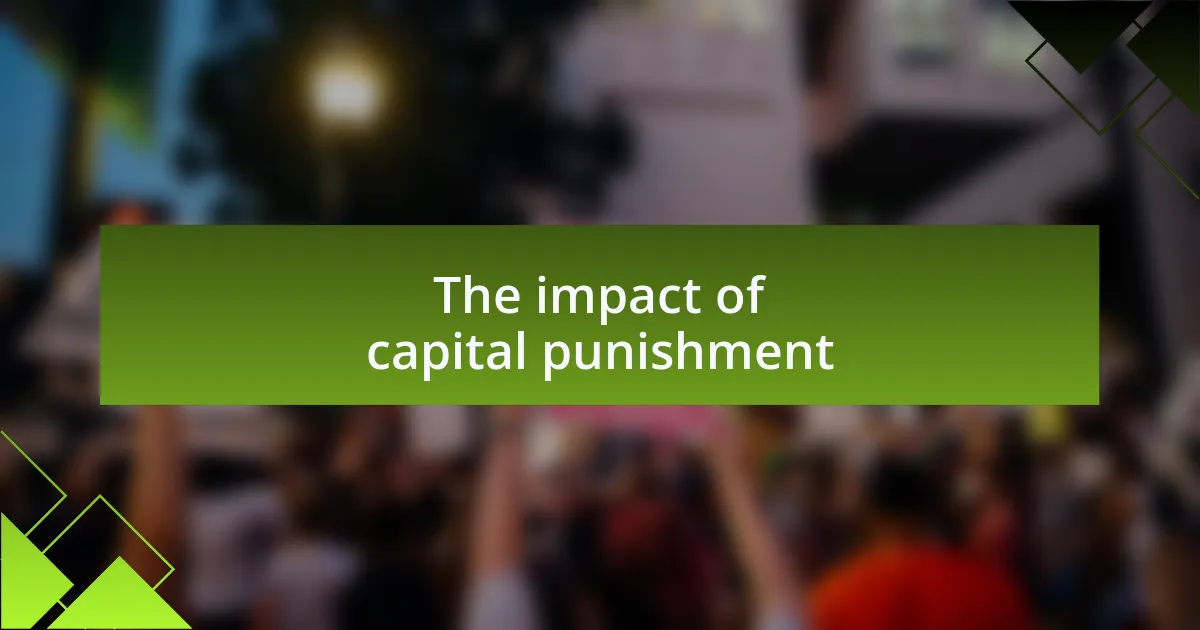
The impact of capital punishment
The impact of capital punishment resonates deeply within society, sparking a myriad of moral and ethical dilemmas. I remember attending a panel discussion where a former death row inmate shared his experience of waiting for execution, only to be exonerated later. Listening to his story was profound; it really hammered home the unsettling truth that irreversible mistakes can lead to grave injustices.
Economically, capital punishment creates significant burdens on taxpayers, with costs associated with lengthy trials, appeals, and incarceration often far exceeding those of life sentences. It makes me wonder, why do we continue to invest so heavily in a system that perpetuates harm instead of fostering rehabilitation? The financial implications alone should compel us to reconsider the rationale behind maintaining such a punitive approach.
On an emotional level, witnessing the pain and loss on the families of both victims and those executed can be heart-wrenching. I recall a conversation with a mother who had lost her son to a violent crime, only to feel further anguish knowing that another family was facing the death of their loved one, despite their innocence. This complexity of grief really highlights an uncomfortable truth: capital punishment doesn’t just claim one life; it ensnares entire communities in a cycle of suffering and revenge.
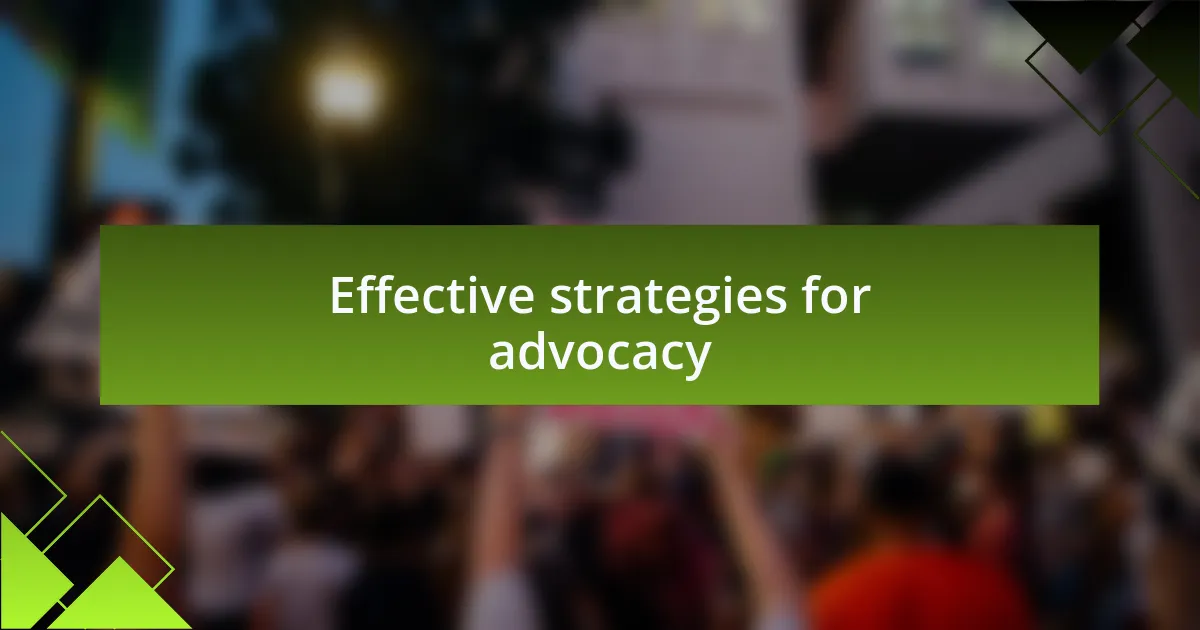
Effective strategies for advocacy
One effective strategy for advocacy is storytelling. I remember attending a community meeting where an activist shared her journey of losing a loved one to violence. Instead of focusing solely on her grief, she emphasized the broader implications of capital punishment on families like hers. This personal narrative resonated with the audience, creating an emotional connection that statistics alone could never achieve.
Engaging in grassroots organizing can also galvanize support for the anti-death penalty movement. I once participated in a march that united diverse voices, from former inmates to social justice advocates. The collective energy was palpable, illustrating how powerful it is when individuals come together for a common cause. It made me realize that local efforts are essential; they create a ripple effect that can influence national conversations and policy changes.
Utilizing social media as a platform for advocacy has proven invaluable in recent years. I often find myself sharing articles and personal reflections on platforms like Twitter, and I’ve seen firsthand how quickly a message can spread. This digital approach allows for broad engagement, enabling discussions that transcend geographical boundaries and reaching those who may not have considered the complexities of capital punishment before. It’s a reminder that advocacy is evolving, and we must adapt our strategies to connect with a changing audience.
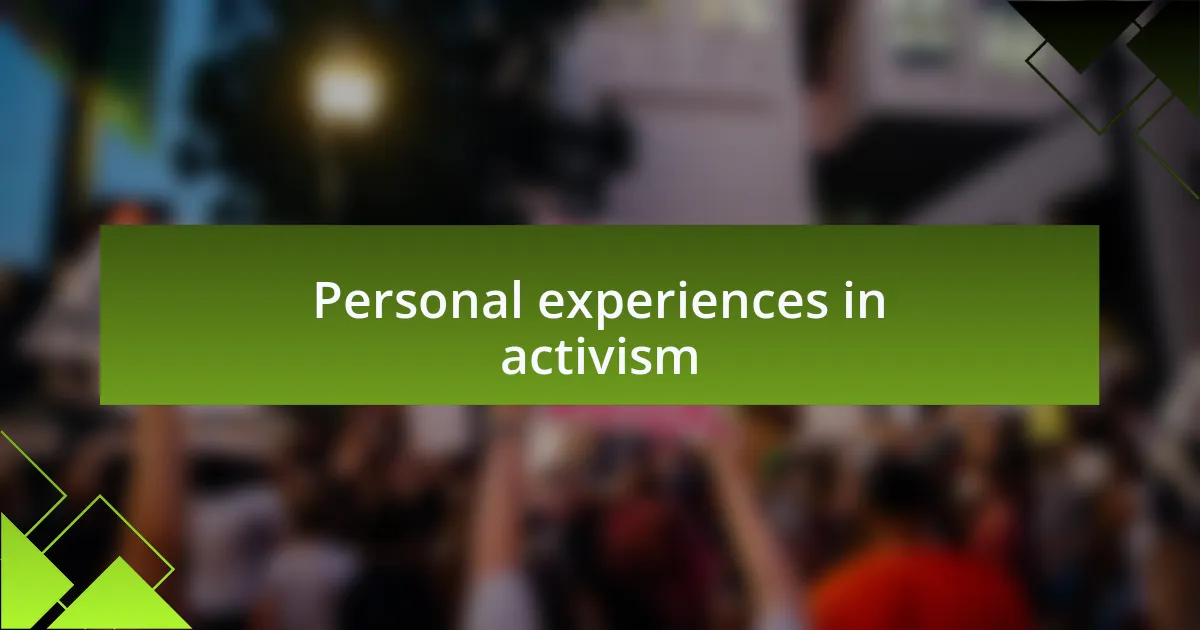
Personal experiences in activism
One of my earliest experiences in activism was when I volunteered at a local nonprofit advocating against the death penalty. I vividly recall sitting across from a mother who had lost her son to violence, listening as she expressed her pain and her belief that taking another life would not bring her peace. How do you comfort someone who has faced such profound loss while also understanding their perspective against the backdrop of a much larger debate? It taught me that empathy must be the cornerstone of any effective campaign.
Participating in a public forum about the death penalty opened my eyes to the diverse perspectives within the community. I was surprised by the number of people who were hesitant to share their views, fearing backlash from peers or family. This moment highlighted an essential insight for me: fear can be a powerful barrier to speaking out. I realized that providing a safe space for conversation and discussion is just as vital as the advocacy itself. Isn’t it fascinating how much silence can stifle change?
More recently, I found myself engaged in a letter-writing campaign targeting local lawmakers. As I poured my thoughts into each letter, I couldn’t help but think about the individuals on death row—real people with stories, families, and dreams. Writing those letters felt like a tangible way to make a difference, and I often wondered, am I making enough of an impact? Each response I received, whether supportive or dismissive, reminded me that every small action contributes to the broader movement for justice and humanity.
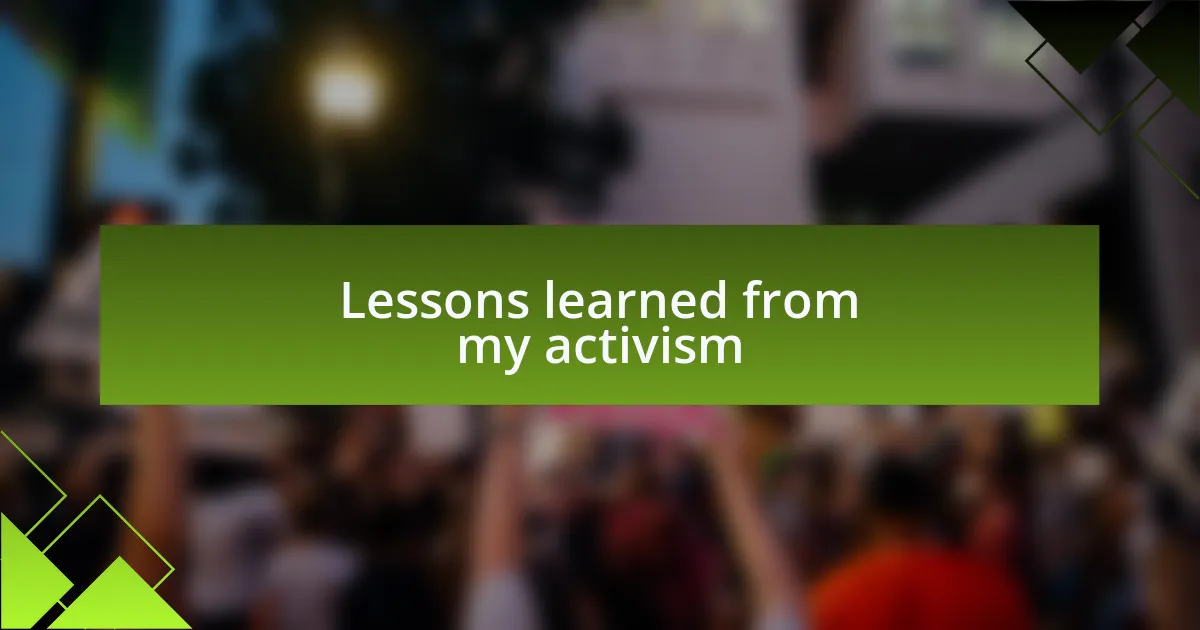
Lessons learned from my activism
Activism has taught me a profound lesson about the power of listening. I recall attending a rally where a former prison inmate shared his journey of wrongful conviction. His voice echoed with emotion, and I found myself deeply moved by his resilience. It was a stark reminder that the stories behind the statistics are what truly drive change. How often do we overlook the human element when discussing policies or reforms? I learned that storytelling can unify our message.
Another important realization was the necessity of persistence. I remember a long meeting with a group of fellow activists where our ideas felt like they were being met with indifference. Yet, through discussions and debates, we managed to refine our arguments and strategies. I came to understand that activism isn’t always about immediate victories. It’s about the long game—planting seeds that may take time to grow. How many of us give up too soon, unaware of the impact we might still have?
Finally, I’ve learned that self-care is crucial in the demanding world of activism. During a particularly intense campaign, I neglected my own well-being, believing I could push through anything for the cause. Yet, I reached a point where I felt burnt out and drained. That experience taught me that to advocate effectively, I must prioritize my mental and emotional health. Reflecting on this, I realized that a sustainable movement needs passionate individuals who take care of themselves as much as they care for others. Is it possible to genuinely fight for change if we don’t first ensure our own resilience?